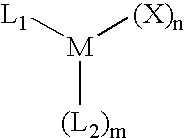Olefin polymerization with pyridine moiety-containing single-site catalysts
- Summary
- Abstract
- Description
- Claims
- Application Information
AI Technical Summary
Benefits of technology
Problems solved by technology
Method used
Image
Examples
example 1
Polymerizing Ethylene with Supported 8-Quinolinoxytitanium Tribenzyl in the Presence of Clay
(A) Preparing 8-Quinolinoxytitanium Trichloride
Under nitrogen, 8-quinolinol powder (1.45 g, 10.0 mmol) and heptane (100 mL) are added to a flask and stirred. The stirring rate is adjusted to prevent solids from depositing on the walls of the flask. Titanium tetrachloride (10 mL of 1.0 M solution in heptane) is added dropwise to the flask over 20 hours at 25° C. at a stirring rate effective to prevent solids from depositing on the walls of the flask. The reaction mixture changes from white to tomato-juice red. The solids are isolated by decanting the liquid portion. Residual solvent is removed from the solids under vacuum, resulting in a red solid, which is 8-quinolinoxytitanium trichloride (3.04 g).
(B) Preparing 8-Quinolinoxytitanium Tribenzyl
8-Quinolinoxytitanium trichloride (0.060 g, 0.2 mmol, prepared in (A) is mixed with toluene (10 mL). Benzylmagnesium chloride (0.60 mL of 1.0 M ...
example 2
Polymerizing Ethylene in the Presence of Clay
Example 1 is repeated, but in step (D), the clay is not heated at 150° C. for an hour. Rather, the empty reactor is heated at 130° C. for an hour, purged with nitrogen for 3 times, and then sealed and cooled to 25° C. The clay (5 g), supported quinolinoxytitanium tribenzyl (0.05 g), triethylaluminum (TEAL) (0.60 mL, 1.6 M in isobutane), and hexane (1,000 mL) are charged into the reactor. After the reactor contents are heated to 60° C., ethylene, dried by passing through 13X molecular sieves, is fed into the reactor via a pressure regulator to start the polymerization. The polymerization is performed at 70° C. by continuously feeding ethylene to maintain the reactor pressure at 550 psi. The polymerization is terminated by venting the reactor. Butylated hydroxytoluene (1,000 ppm) is added to the polymer. The polymer is dried for an hour at 80° C. under vacuum. It has Mw: 5.14×106 g / mol. and bulk density: 0.32 g / cc. The catalyst activity i...
example 3
Polymerizing Ethylene in the Presence of Clay
Example 1 is repeated, but in step (D), the clay is pre-heated at 150° C. for an hour outside of the reactor. The reactor is heated at 130° C. for an hour, purged with nitrogen three times, and then sealed and cooled to 25° C. The pre-heated clay (5 g), supported quinolinoxytitanium tribenzyl (0.05 g), triethylaluminum (TEAL) (0.60 mL, 1.6 M in isobutane), and hexane (1,000 mL) are charged into the reactor. After the reactor contents are heated to 60° C., ethylene, dried by passing through 13X molecular sieves, is fed into the reactor via a pressure regulator to start the polymerization. The polymerization is performed at 70° C. by continuously feeding ethylene to maintain the reactor pressure at 550 psi. The polymerization is terminated by venting the reactor. Butylated hydroxytoluene (1,000 ppm) is added to the polymer. The polymer is dried for an hour at 80° C. under vacuum. It has Mw: 5.08×106 g / mol. and bulk density: 0.31 g / cc. The...
PUM
| Property | Measurement | Unit |
|---|---|---|
| Temperature | aaaaa | aaaaa |
| Temperature | aaaaa | aaaaa |
| Density | aaaaa | aaaaa |
Abstract
Description
Claims
Application Information
 Login to View More
Login to View More - R&D
- Intellectual Property
- Life Sciences
- Materials
- Tech Scout
- Unparalleled Data Quality
- Higher Quality Content
- 60% Fewer Hallucinations
Browse by: Latest US Patents, China's latest patents, Technical Efficacy Thesaurus, Application Domain, Technology Topic, Popular Technical Reports.
© 2025 PatSnap. All rights reserved.Legal|Privacy policy|Modern Slavery Act Transparency Statement|Sitemap|About US| Contact US: help@patsnap.com


